
Southwell workhouse: front. [Click on all the thumbnails for larger photographs and additional information.]
At the end of the French Wars the cost of poor relief reached new heights. In 1784, it was estimated that poor relief cost £2 million; by 1815 it had reached £6 million, at a time when attitudes towards poverty and the poor were beginning to change. In the period following the passing of the Elizabethan Poor Law (1601) it was generally accepted that the poor should be looked after but increasingly, it was felt by the ratepayers that poverty was the result either of idleness or of a personality defect. Consequently, it was thought that the poor should be encouraged to find work or be "taught the error of their ways." Nottinghamshire was the first area to implement a system of poor relief that was intended to deter the poor from seeking parish relief and hence reduce the poor rates. The implementation of the idea was largely the work of the Rev. John Becher; he insisted that those claiming poor relief would be institutionalised in conditions "less eligible" than those of the poorest labourer outside the workhouse. Others who were involved in the "Nottinghamshire reforms" were George Nicholls and the Rev. Robert Lowe.
Nicholls became an overseer for the parish of Southwell in the early 1820s and was responsible for putting into practice a system of poor relief recommended by the Rev. Robert Lowe Becher's cousin and the vicar of Bingham near Nottingham. Lowe had virtually abolished outdoor relief, offering instead only the workhouse. Nicholls did the same at Southwell and reduced the parish's poor relief expenditure from £1,884 in 1821-2 to £811 in 1822-3.
In 1824 Thurgarton Hundred Incorporated workhouse was opened. The institution cost £6,500 to construct and stood in its own grounds of ten acres comprising the building itself, an orchard and garden. The establishment also had its own byre and pasture for the establishment's cows.
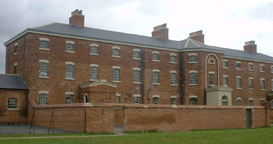
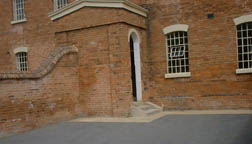
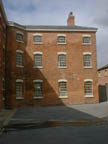
Left: Master's quarters (in the centre on the first and second floors in the projecting section) and men's area. Middle: able-bodied men's exercise yard. Right: The able-bodied men's work yard.
The workhouse was able to accommodate 158 paupers: they were admitted from all of the neighbouring forty-nine parishes. Male inmates were housed in the east wing (right of photo); women were housed in the west wing (left) and children were kept in quarters at the back of the building. The workhouse master's quarters were at the centre of the building where he could see all the exercise yards.
The purpose of the workhouse was to discourage the poor from claiming poor relief. It was intended to "dis-pauperise" districts: that is, to make conditions so harsh and uncompromising in the institutions that people would prefer to try to manage outside, rather than enter them. It was thought that the poor were idle and would do almost anything other than look for employment. The ratepayers seemed not to consider the fact that employment was increasingly difficult to find and that wages were too low for subsistence.
Those who claimed poor relief and entered the workhouse were called "inmates" — a term also used for criminals who were in prison. In accordance with the instructions of the Poor Law Commission, on admittance the inmates' own clothes were taken away from them and each was given a uniform to wear.



Sophie and Edward from Nottingham, dressed in workhouse uniforms.
In order to earn their food, inmates were expected to do work of some description. For the men, this could be stonebreaking, bone crushing, hole-digging (to fill in again, once finished) or working the corn mill. At Southwell, painting the walls, apparently an interminable task, was another alternative. Women would be set to work cleaning, polishing, scrubbing, sweeping or doing other domestic duties such as mending.

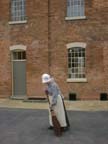

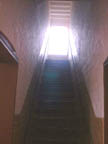
Left to right: (a) A small section of one of the original walls at Southwell, showing a series of layers of paint that cover the bare bricks. (b) Women's work at Southwell. The "inmate" is sweeping the yard using a besom broom. Her uniform is typical of workhouse wear. (c) The women's work yard at Southwell workhouse with the well is in the foreground: the female "inmate" continues to sweep. (d) A staircase at Southwell.
Southwell workhouse had a sopisticated system of double stairs. This ensured that none of the inmates in one group ever came into contact with inmates in another group, since the four staircases were separated from each other. All the staircases for the inmates were dark and steep; no concessions were made for elderly paupers who had to climb to the second floor to the dormitories. The workhouse Master had a much lighter, broader staircase to his quarters.
Last modified (reformatted) 25 January 2021